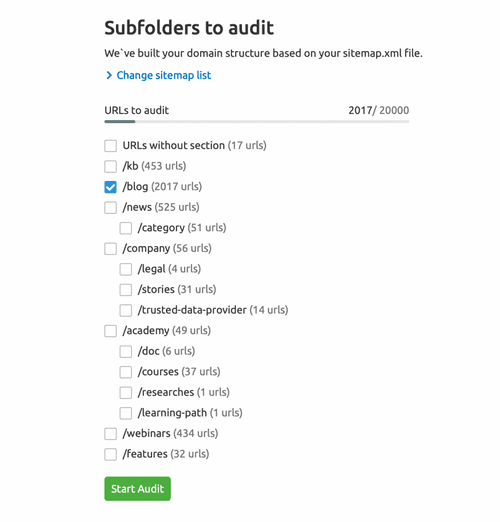Explore the World's Best Ideas
Join today and uncover 100+ curated journeys from 50+ topics. Unlock access to our mobile app with extensive features.
What Is A Content Audit?
A content audit is the process of systematically analyzing and assessing all the content on your website. The final objective is to reveal strengths and weaknesses in your content strategy and content development workflow, and adapt your content plan to your current marketing goals.
31
134 reads
Step 1: Define Your Goals and Metrics
A content audit is a difficult & time-consuming process, it is important to begin with clear, defined objectives.
The first step is to think about your business goals (e.g. SEO, engagement, conversion, etc). What benefits can you gain from a content audit? What are the results you want to achieve?
Content marketing metrics:
- SEO: Organic traffic, backlinks, keyword rankings, dwell time, etc;
- User behavior: Pageviews, average session duration, bounce rate, etc;
- Engagement: Likes, shares, comments, mentions, etc; &
- Sales: Number of leads, conversion rates, ROI, etc.
34
76 reads
Step 2: Take An Inventory of Your Content
Before creating an inventory of URLs and metrics, it is important to decide what kind of content you are going to review.
You need to start your inventory by collecting all the URLs of pages you want to analyze.
After collecting your URLs, sort them by different criteria, & track it with your team members.
Catalog your content by the following categories:
- Buyer’s journey stage
- Content type
- Content format
- Number of words
- Date of publication or last modification
- Content hub
- Author
29
72 reads
Step 3: Collect and Analyze Data
Examine your content metrics as a whole to gain a clear picture of the state of your site’s content.
Take into account the different stages of the buyer’s journey. Your ‘Awareness’ content may attract more traffic, but have a lower conversion rate. Your ‘Consideration’ content may have less traffic, but generate more leads, and so on.
Assess each piece of content according to your goals, and assign one of the following statuses: Keep/Update/Delete.
28
45 reads
Step 4.1: Draw Up An Action Plan (Prioritize Your Actions)
Before drawing up an action plan for each URL, refer to the goal(s) you set out in step 1. Each investment in your content plan should align with a goal.
Next, prioritize actions based on how achievable the goals are in line with the effort required.
Add a priority column to your spreadsheet after you’ve weighed up the resources required against the expected results.
29
49 reads
Step 4.2: Draw Up An Action Plan (Create an Action Plan for Each URL)
Actionable tips to include in your content audit workflow for individual pages:
- Reuse: Combine different pieces of content to create another one or publish in a different format.
- Rewrite: Rewrite underperforming content with examples, tips, & practical details.
- Expand: Add more detail to your existing articles.
- Refresh: Add new/relevant information.
- Structure: A clear & logical structure with relevant H2 & H3 tags can help users & bots better interpret your content, & boost traffic. Well-structured articles are more likely to rank for Featured Snippets.
28
47 reads
Step 4.2: Draw Up An Action Plan (Create an Action Plan for Each URL) (contd.)
- Update CTAs: Replace outdated CTAs with relevant ones to reactivate your content marketing funnel & improve conversion rates.
- Add videos
- Add images
- Optimize metadata: Rewrite titles, meta descriptions, & h1. Use better keywords to make it more natural & attractive for users & search engines.
- Optimize internal linking: Add links pointing to posts with related topics. This can improve website organization, and decrease bounce rate. Optimize your internal linking according to the buyer’s journey: Awareness content should link to Consideration content which should link to Decision content.
28
31 reads
Step 4.2: Draw Up An Action Plan (Create an Action Plan for Each URL) (contd.)
- Use 301 redirects for web pages removed from your website to avoid "not found" pages & improve user experience.
- Inform Google about your content updates by using Google Search Console. The URL Inspection tool within Search Console allows you to submit recently updated web pages to Google's index.
28
32 reads
Step 5: Adjust Your Content Marketing Strategy
It is important to keep your long-term marketing strategy in mind. Track your successes & failures & steer your content strategy in different directions to appeal to your target audiences in other ways, adjust assets for better organic reach, & improve conversion rates.
Note what works & expand upon it. Look at your least successful content, & check your competitors' similar successful content to see where & how you could improve.
Reviewing your content marketing strategy is needed at least once a year to ensure your tactics & activities still fit your goals.
29
39 reads
IDEAS CURATED BY
Digital Marketer Welcome to my Deepstash where I share ideas I find most valuable for those who wish learn more about digital marketing!
Madhav 's ideas are part of this journey:
Learn more about marketingandsales with this collection
How to develop a growth mindset
How to think creatively and outside the box
How to embrace change
Related collections
Similar ideas
Read & Learn
20x Faster
without
deepstash
with
deepstash
with
deepstash
Personalized microlearning
—
100+ Learning Journeys
—
Access to 200,000+ ideas
—
Access to the mobile app
—
Unlimited idea saving
—
—
Unlimited history
—
—
Unlimited listening to ideas
—
—
Downloading & offline access
—
—
Supercharge your mind with one idea per day
Enter your email and spend 1 minute every day to learn something new.
I agree to receive email updates

